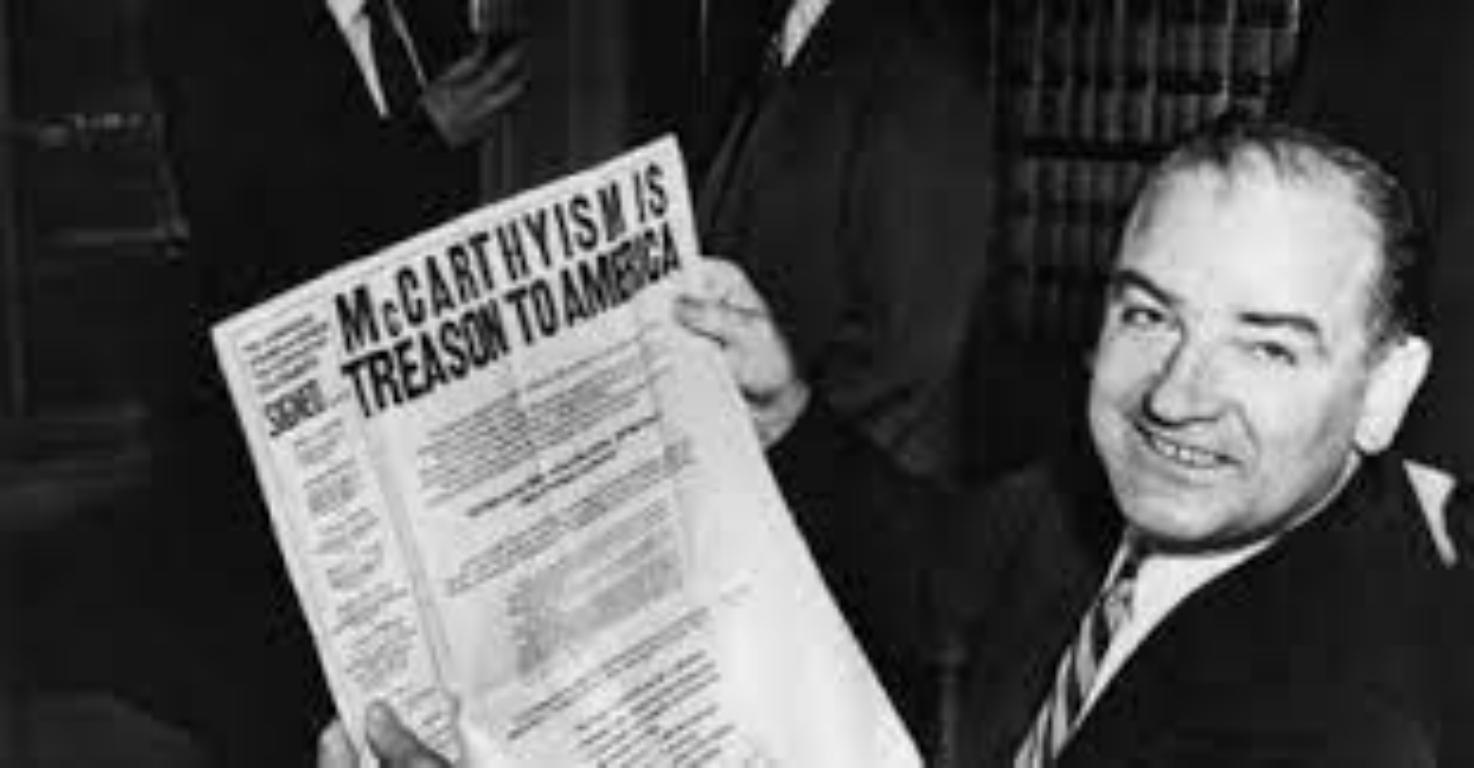The United States Congress passed a resolution condemning “socialism” at the beginning of February. This “concurrent resolution” was titled “Denouncing the horrors of socialism.” Such scary words set the stage for lies about what socialism is. it also gives insight into the fears of the ruling class in the most powerful country in the world, as well as its intention to further attack concessions won by the American working-class, through struggle, over the last century.
While the motion was moved by Republicans, it had the endorsement of Democrats as well, despite the fact that several liberal policies that democrats have passed when in government have been loosely described as “socialist” by Republicans.
The motion was passed with 328 votes in support and 86 against. The 219 Republicans in Congress supported it, without any opposing voice in their ranks. Of the Democrats, 109 joined this lynch mob, despite the fact that their proposed amendment to the resolution with the clause “that opposition to the implementation of socialist policies in the US does not include federal programs like Medicare and Social Security,” was thrown out.
Unstated horrors: the bloodied hands of capitalism
The resolution claims that “socialism has repeatedly led to famine and mass murders and the killing of 100,000,000 people worldwide,” and adds that “the greatest crimes in history were committed by socialist ideologues,” lumping together a list of disparate historical figures ranging from Vladimir Lenin to Joseph Stalin, Fidel Castro, Pol Pot, Kim Jong Il, Daniel Ortega, and Hugo Chavez.
But what the resolution actually does not do is define what socialism actually is. Socialism is the body of theory and movement of working-class people to liberate themselves from capitalist exploitation and its horrors, by overthrowing the ruling capitalist class and enthroning the fullest of democracy, across the world.
So, the very first point to note is that the need for socialism itself emerges from and is in response to capitalism which puts the profit of the 1% over and above the lives of the 99% of humankind.
Capitalism results in tens of millions of deaths every year. These include almost 3 million people who die from avoidable occupational accidents and diseases in the workplace every year because maximizing profit is more important to capitalists than ensuring workplace safety for workers.
The report also fails to note that in a world awash with abundance, 25,000 people die from hunger every day. That is well over 9 million people every year, out of which 3.1 million are children, according to the United Nations. And this is the same world where the United States government dumps food into lagoons and manure pits to ensure that prices do not fall due to over-supply, in line with the capitalist god of “demand and supply”!
And what about the wars which burst out due to imperialist rivalries between capitalist powers? Upwards of 22 million people were killed in World War I alone, the majority of whom were civilians. The figures for World War II range from 70 million to 80 million people, which was 3% of the global population of 2.3 billion people at the time. Added together, at least 231 million were killed in wars during the 20th century. And most of these were by and fought directly by imperialist powers or through their proxies, over control of resources.
If we go further back we can see how devastating capitalism has been as a “vampire sucking the blood of the sufferers” across the world. Just between 1880 and 1920 alone over 100 million lives were lost in India due to capitalist colonialism. Some other scholarly figures put the figures in this period at 165 million people killed, and also show the connections between colonialism and fascism.
But the most important point that undermines the argument of the anti-socialist lies and distortion of the American Congress is captured by Dylan Sullivan and Jason Hicekl when they aptly point out that “colonial policies in India claimed more lives than all famines in the Soviet Union, Maoist China, and North combines,” in just forty years.
Coming closer home the number of Africans killed or displaced by capitalist ventures from the period of the trans-Atlantic slave trade to the end of direct colonialism can also not but be hundreds of millions of people.
13-15 million Africans were kidnapped and enslaved between 1501 and 1867. One out of 12 of these, i.e., definitely over 1 million people died on the high seas during the middle passage, as they at times call it. And during colonialism, over 10 million were killed in the Congo alone between 1885 and 1908. “Some say the estimated total….could be double the number.”
“Pacification” exercises by British, French, and Portuguese colonialism in the last quarter of the nineteenth and early twentieth centuries also led directly to millions of deaths directly and as a result of capitalist-colonial economic policies that were subsequently put in place.
German imperialism was also not found wanting in sucking our people’s blood. About 65,000 Herero and 10,000 Nama peoples were murdered in Namibia, in what was the first genocide of the twentieth century.
The mind-boggling number of deaths that can be laid directly at the doorsteps of capitalism are not only from wars and starvation as a result of for-profit economic policies. Virulent pandemics such as Ebola and COVID-19, and the climate crisis which could lead to the extinction of life on earth are also direct consequences of capitalist “development.”
As scholars such as Mike Davis and Rob Wallace have pointed out on several occasions, industrial animal husbandry facilitates the emergence and spread of “big flu” of different sorts. And in the case of COVID-19, countries across the world were left ill-prepared due to years of cuts in governments’ funding of social services such as public healthcare delivery and public education. In place of this, privatization had become the global norm. Thus was the wealth of a few and their corporations put before the health of billions of people.
It was bad enough that the dynamics of capitalism left the world unprepared. But even in the pandemic response, money-making for the rich was put before saving the lives of the immense majority of humankind.
Vaccine imperialism was just the most graphic of this horror of capitalism. Trade rules that ensured the sanctity of the god of capitalism (i.e., maximisation of profit) constrained the availability of personal protective equipment for health workers, as well as ventilators and other medical devices. Thus, whilst over 30 new billionaires emerged in the course of the pandemic, millions of people might have been alive with us today if the people’s needs could have been put before capitalists’ greed are dead. In all, some 20 million lives have been lost to the pandemic. A significant number of these would still be alive today, but for the way, capitalism works.
Distortions, lies, and malicious intent
There is absolutely no doubt that capitalism has been a wellspring of horrors for working-class people across the world. But that is not enough for us to dismiss the mischievous allegations of the US Congress, meant to discredit socialism.
To understand the distortions that these allegations are, we must understand what socialism is, not as something that springs from the heads of some socialist ideologues as they want us to believe, but as material social evolution of human history.
At the heart of socialism, be this as theory, movement, or post-capitalist system is the working class self-emancipation. It entails the fullest democracy in all aspects of social life and the collective management of production by working-class people to fulfill their needs. We have seen flashes of what socialism as a system is and can be at key revolutionary moments in history. The two most significant of these are the 1871 Paris Commune and the Soviets of 1917 Russia.
While the socialist revolution could commence in one or a few countries, it has to spread across the globe, it has to be international otherwise, as we saw in Russia shortly after the 1917 revolution, it will be consumed by both external pressures and internal smothering of workers’ democracy – which is the life breath of socialism – from within.
External pressures include armed intervention. Eighteen capitalist countries invaded Russia in 1918, to smash the nascent efforts at building socialism, out of the murk of capitalism, in an economically backward country. But external pressures go beyond wars of aggression. They are as well, and in the long run, are primarily economic. There was, and still is one world economy and it is capitalist. The Soviet Union competed (and also collaborated) with western imperialism under the leadership of the United States within this global capitalist economy and world geopolitics.
And by the end of the 1920s, the power of the working class which was in its glory in 1917 had been fully usurped by the Stalinist bureaucracy which became a new ruling class. The nomenklatura as this bureaucracy was called in Russia took the place of the bourgeoisie in conventional capitalism.
Acting collectively it ran the Soviet economy on a state-capitalist basis. Socialism became first and foremost an ideology for modernization, first in the USSR, and later in other economically backward “people’s democracies” across the world.
Some might argue of course that the Soviet Union continued to describe itself as socialist. And that, truly speaking it guaranteed social and economic rights like you never could find in bourgeois capitalist countries until it did not. But that does not make it any more socialist than the fact that a king reigns in the United Kingdom, with lords that even have their own legislative house would make today’s once Great Britain a feudal state.
Despite all its hue and cry against what many described as “actually existing socialism” at the time, the United States realized that in the essential sense of economic base, it shared a lot more with the Soviet Union than appeared to be the case. The two countries established full diplomatic relations in 1933, with the United States recognising Stalin’s USSR as the successor of the Russian Empire, much the same way as Yeltsin’s and later Putin’s Russian Federation would be recognised as the successor of the USSR.
The brutality of Stalinism served the United States very well. It could pass off that monstrosity as what socialism is supposed to be and use this to justify attacks on Communists and the very idea of revolutionary socialism.
It is also instructive that “the United State gave the Sihanouk-Khmer Rouge coalition millions of dollars in aid while enforcing an economic embargo against the Vietnamese-backed Cambodian government.” The reign of the same murderous Khmer Rouge is listed as a “socialist experiment” of horror in this resolution!
The simple fact of the matter is that the United States government has never been interested in how horrific a regime is or is not. Its interests have always been to defend global capitalism and its captainship by the American ruling class.
Why such a resolution now?

The question that should be on the minds of working-class and youth activists, in the United States and across the world, should be why is this resolution being passed, and now? The straightforward answer is that the ruling class of the most powerful (capitalist) country in the world is afraid.
They are afraid because a new generation is gradually losing hope in the false promises of capitalism. They are afraid that youths whose minds they cannot poison by pointing at the Stalinist monstrosity in Russia as socialism are now turning in their millions to the idea of socialism.
In 2021, the Heritage Foundation which is a major ideological backbone of the right-wing/Republican faction of the American ruling class expressed this view succinctly when it screamed: “young Americans increasingly prefer socialism.” And of course, it made proposals on “how to change their minds.”
However, since then the inability of capitalism to secure the future of humankind has become ever clearer to this young generation which is witnessing economic hardships in so many ways, health inequities, the climate crisis, and environmental emergency.
This young American generation and a reawakening working class in the country are living in a world where the deepening global crisis of capitalism is sharpening mass revolts and throwing up revolutions, which further embolden struggles in the USA.
A good example is how the “Arab Spring” inspired tens of thousands of workers, students, and other marginalised citizens to protest for labour and trade union rights in Wisconsin in February 2011. And it did not end there. A worldwide roller coaster of strikes and protests swept through the year 2011, crisscrossing all continents, and back to the United States with Occupy Wall Street. And in 2020, the anti-racist and anti-police brutality rebellion that was ignited by the killing of George Floyd shook the United States, probably like no wave of protests ever before. It also inspired an avalanche of similar protests worldwide.
This rising colossus of mass strikes and protests, trying to find its theoretical heart and better define the pathway of its feet, as it draws lessons from each step it takes, is what strikes fear in the heart of the American ruling class.
The anti-socialist resolution should not be treated lightly. There are two earlier moments in the twentieth century when the bosses in the US launched anti-socialist scares. The first “Red Scare” was in the immediate wake of the Russian revolution and it lasted till 1920. As Murray B. Levin, who used to be a member of the Communist Party USA, described it, it was “a nationwide anti-radical hysteria provoked by a mounting fear and anxiety that a Bolshevik revolution in America was imminent—a revolution that would change Church, home, marriage, civility, and the American way of Life.”
The second which is better known as “McCarthyism” started with the Cold War, immediately after World War II, and lasted ten years. There was a massive crackdown on radical and revolutionary forces. Anarchists, socialists, communists, or people suspected to have “sympathetic association” with organisations that had such ideological persuasions were labelled as subversives and hounded.
The main instrument used for this purpose was the House Committee on Un-American Activities (HCUA) which however was better known as the House Un-American Activities Committee (HUAC). While it became a standing committee only in 1945, it had been established seven years earlier.
Thus, this nefarious Congress resolution should be seen as a sign of what is to come. It is an embryo of intended reactionary repression of the coming waves of revolutionary resistance that looms on the horizon. When a new wave of something similar to #OccupyWallStreet commences, it will have more powerful ideas behind it. And this is exactly what the bourgeoisie wants to kill before it is born. But they cannot stop an idea whose time has come.

by Baba AYE









